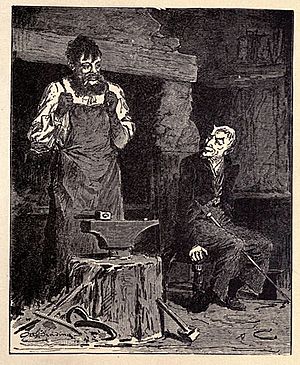The Smith and the Devil facts for kids
The story of The Smith and the Devil is an old European fairy tale. It's about a blacksmith, a person who works with metal, who makes a special deal with a powerful, often evil, being. This being is usually the Devil, but sometimes it's Death, a demon, or a genie. The blacksmith sells his soul to get a special power. But then, the clever smith tricks the evil being and gets out of the deal!
In one popular version, the smith gains the power to weld any material together. He uses this power to stick the Devil to something that can't be moved, like a big tree or a wall. This way, the Devil can't take his soul, and the smith wins the bargain.
Contents
The Story of The Smith and the Devil
Who Collected This Tale?
This famous tale has been told and written down by many people over hundreds of years. One of the first to collect it was Giambattista Basile in his book Lo cunto de li cunti in 1634.
Later, the famous Brothers Grimm included it in their Children's and Household Tales in 1812 and 1815. However, they removed it from later versions of their book.
Other people who collected different versions of the story include Edith Hodgetts in her 1891 book Tales and Legends from the Land of the Tsar, which has a Russian version. Ruth Manning-Sanders also included a version from Gascony, a region in France, in her 1970 book A Book of Devils and Demons. An American version from the Southern Appalachians is called "Wicked John and the Devil," collected by Richard Chase.
Blacksmiths in Old Stories
According to George Monbiot, blacksmiths often appear in old stories and folklore across Europe. Sometimes, they are linked to powerful or even scary things. For example, the idea of Hell in medieval times might have been inspired by the image of a smith working at his hot forge. Many tales tell of smiths making deals with the Devil to get fire or learn how to work with metal.
How Old Is This Story?
Scientists who study folklore and languages have looked into how old "The Smith and the Devil" might be. Using special methods, they think it could be one of the oldest European folk tales. The main plot of the story has stayed the same across many Indo-European speaking parts of the world, from India to Scandinavia.
Some researchers believe the story might have first been told about 6,000 years ago during the Bronze Age. However, another folklorist, John Lindow, points out that the word "smith" might not have existed in the very early Indo-European language. If that's true, the story might not be quite that old.


